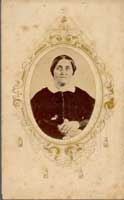I felt an immediate affinity for my guest this month, Linda S. Johnston. Not only are we the eastern stronghold of Women Writing the West, but we have both lived in Great Britain and have both moved house an inordinate amount of times. While I beat Linda in years spent in the U.K., she certainly outdoes me in moves—more than fifteen, including places as diverse as Margate, England; Seattle, Washington; and Roswell, New Mexico. But it was when she landed in Kansas in 1986 and began reading pioneer diaries that she felt a connection to the emigrants; she knew the emotions of packing up and moving on, leaving familiar places and faces for the unknown. As a writer, artist and naturalist, she combines history, art and nature in her writing as is evident in her first book, Hope Amid Hardship: Pioneer Voices from Kansas Territory.
Not only are we the eastern stronghold of Women Writing the West, but we have both lived in Great Britain and have both moved house an inordinate amount of times. While I beat Linda in years spent in the U.K., she certainly outdoes me in moves—more than fifteen, including places as diverse as Margate, England; Seattle, Washington; and Roswell, New Mexico. But it was when she landed in Kansas in 1986 and began reading pioneer diaries that she felt a connection to the emigrants; she knew the emotions of packing up and moving on, leaving familiar places and faces for the unknown. As a writer, artist and naturalist, she combines history, art and nature in her writing as is evident in her first book, Hope Amid Hardship: Pioneer Voices from Kansas Territory.
After extensive research to bring the personal writings of these settlers to others, and share the happier side of pioneer life, Linda is quite an expert on the role of newspapers in Kansas Territory. I’m delighted for her to be here to share her thoughts with you. *********************************************************************** “The Press, Watson, is a most valuable institution, if you only know how to use it.” –Arthur Conan Doyle, The Adventures of the Six Napoleons/ The Adventure of the Crooked Man
Indeed, people did know how to use the press in regards to Kansas Territory. Perhaps not exactly the way Arthur Conan Doyle meant, but between 1855 and 1860 over 98,000 people settled in Kansas Territory and in some way, newspapers touched them all.
Newspapers served a number of roles in the new territory, carved out of the Louisiana Purchase by the 1854 Kansas-Nebraska Act. For the prospective pioneer, eastern newspapers offered various types of information on the frontier – travel advice, encouragement (“The man who comes here self-reliant will do well”), and news that consisted mainly of debate on the slavery issue. When Kansas Territory was established, it was left to the citizens to decide whether the future state would enter the union as a slave state or free state. Newspapers of both persuasions were up and running early in Leavenworth, Lawrence, and Topeka, the first towns to be settled. Once the emigrants had arrived in their adopted communities, local newspapers provided national and world news as well as information on entertainment, business, and agriculture. Feature articles covered holidays, social events, and the virtues of women. And lest readers become discouraged with their new life, papers such as the Herald of Freedom and Kansas Tribune, offered words of hope.
Eastern cities kept up with events in Kansas through reporters, families of settlers, and subscribers who traveled west, becoming pioneer correspondents.
Julia Louisa Lovejoy settled in Kansas in 1855 with her husband and children. Two weeks after arriving, despite being heartbroken after the death of her young daughter, Julia began reporting to her “New England friends” on the pages of her hometown Concord, New Hampshire, Independent Democrat.
Mouth of the Big Blue River, K.
May 22d, 1855
We arrived at our intended home about two weeks ago, and, notwithstanding the Vacant spot in the home circle, and our own desolate hearts, we must pronounce this the most charming country our eyes ever beheld. . . It seems to us impossible that any spot on earth, uncultivated by art, can be more inviting in appearance than this country.
Editors kept the spotlight on Kansas with not only political news, but also geographic, demographic, and economic coverage. On December 25, 1858, Frank Leslie’s Illustrated Newspaper devoted its front page to the “Cities of Kansas” featuring Lawrence, Leavenworth, and Topeka. Horace Greeley, influential editor of the New York Tribune ran stories from young reporter, James Redpath, who went west in 1856 and reported on the volatile atmosphere in the Territory, keeping Northern readers informed of the struggles between slavery and anti-slavery factions.
New Kansans kept up with elections, conventions, and territorial constitutions by reading the latest edition of their local paper. The presses themselves made news
when the offices of the Herald of Freedom and the Kansas Free State were looted and equipment destroyed during the sack of Lawrence in May 1856.
Kansas newspapers brought national and world news to their readers, often juxtaposed with feature articles. In 1855, the Lawrence Herald of Freedom reported on the annexation of the Sandwich Islands to the United States as well as the fall of Sevastopol during the Crimean War. In May 1857, the article “Ocean Telegraph” provided an update on the laying of wire in the Atlantic. Just below that article, a piece entirely devoted to “Female Delicacy” touted the many features of the female character but pointed out that “delicacy stands foremost within the province of good taste.” In addition, newspapers often provided helpful hints, such as how to preserve flowers and the many uses of cotton cloth, one being as roofing material.
In the growing, and sometimes struggling, new communities of Kansas, newspapers offered encouragement to new citizens, sometimes in the form of poetry. “Try Again” appeared in the June 9, 1855 edition of the Lawrence Herald of Freedom:
How oft has disappointment marred
Some cherished plan of mine,
And bid winter clouds appear
Where summer’s sun should shine;
Yet as they darker grew,
I’ve seen some wondrous pen
Upon the very blackest write
The sentence, “Try again.”
Many early settlers in Kansas went for just that reason – to try again. Eager to establish a better life for their families, trades people of all kinds arrived. Advertisements for new businesses, including ones for an ice cream store and a bookbinder, filled columns in local papers. There seemed to be an ad for each segment of the growing population, including those feeling under the weather: “To Invalids: Cornstarch, tapioca, arrow root, and rice for sale.” For those in need of feathers, they were available “by the pound for feather bolsters and pillows.” And to farmers, interested in setting up housekeeping, this ad: “To Farmers: Corn shucks and oat straw wanted in exchange for furniture.”
Also for farmers, newspapers offered information on crops. “How to” articles appeared on planting Osage Orange trees as hedges and sowing turnip seed. Pumpkins, buckwheat, and sorghum made headlines as bumper crops were harvested. For farmers and shopkeeper alike, social activities meant time to visit with friends and neighbors. From the arrival of Mabie’s Circus to the meeting of the Lawrence Sewing Circle, community gatherings were important events and reported accordingly.
Lastly, newspapers provided a link between family and friends – a way to exchange information from hometown to prairie and back again. For a homesick son or daughter, a hometown paper was a welcome and cherished gift to be read over and over. For a parent or friend in the East, news from the Territory kept them informed about the place their loved one had chosen to begin a new life.
Linda has very kindly offered to give one print copy of Hope Amid Hardship: Pioneer Voices from Kansas Territory to one person leaving a comment. The lucky individual is Kathy Gibson. We hope you enjoy reading it!
Despite the challenges of loneliness, drought, and political turmoil Kansas  pioneers faced, many found and wrote about joy and beauty in their adopted communities. Letters and diaries describe the times that gave them reason to sing, dance, and celebrate – moments when their burdens were lighter. This beautifully illustrated volume brings together reflections of sixty individuals of different ages, backgrounds, and outlooks who helped shape the identity of the Sunflower State.
pioneers faced, many found and wrote about joy and beauty in their adopted communities. Letters and diaries describe the times that gave them reason to sing, dance, and celebrate – moments when their burdens were lighter. This beautifully illustrated volume brings together reflections of sixty individuals of different ages, backgrounds, and outlooks who helped shape the identity of the Sunflower State.
Linda Johnston can be found at www.lindasjohnston.com and https://www.facebook.com/pages/Linda-S-Johnston-Author/123981281119230
Hope Amid Hardship can be purchased at http://www.amazon.com/Hope-Amid-Hardship-Pioneer-Territory/dp/0762784865/


















fascinating- I’ve just started researching the same time period
LikeLike
Hi Kathleen,
This is an interesting period in history. I like reading diaries and letters of people who left the familiar for the unknown West. I wrote my book because I had moved so many times and felt a kinship with pioneers.
Thanks for your comment and have fun researching!
LikeLike
Linda – your post hit home for me. I started writing my first novel months after moving to a very small community in Colorado County, Texas. The tiny local weekly newspaper was a life line even in the 1990s. On the third page of the paper was a “clip” from “75 years ago” or “60 years ago.” I saved every one of them and used some of the language in my novels. Funny how the past can intrigue us so – it’s our compass, I guess. Wonderful post. Thanks to you too, Andrea.
LikeLike
What a great idea to use those papers as a language reference. Brilliant! Thanks so much for your comment.
LikeLike
Linda,
Great post. The power of the pen may have reached it zenith in the nineteenth century. Your connection to the Kansas Nebraska Act is very interesting. Andi had me look at the politics of selecting a route for the transcontinental railroad a few months ago. That thread led to Kansas and the very period you write about. It turned into a book idea I’m incubating. It may be a couple of years to completion, but you’ve given me some hints and insights that will help flesh it out. Many thanks.
Paul
LikeLike
Paul,
I am so glad you enjoyed the post. I love networking with other writers as it can lead to some fascinating places. Good luck with your project and if I can help at all, please contact me through the info posted at the end of the blog. Thanks for your comments!
LikeLike
we will never truly understand how difficult it was for our forefathers to “get started”. thank you for posting.
LikeLike
Candace,
It was challenging indeed, but as I discovered in my research, they still managed (and needed) to celebrate the joys, though sometimes small, in their lives. Like us, they needed to have happy times to get through the tough times. Thanks so much for your comments, Candace.
LikeLike
Terrific post, Linda. as a Kansas native I’m always interested in anything pertaining to the history of my home state. Kansas territorial history is particularly interesting, as Kansas was in so many ways ground zero for Western expansion. And the press of the day was a vital part of that.
Well done – thanks!
LikeLike
Thank you so much for commenting, J. R. Westward expansion is my favorite time period in American history. Perhaps because of the feeling of possibility and hope. THough many people don’t know much about Kansas, as you mention, it was a very important “jumping off” place.
J. R., I read your Facebook posts often and am trying to remember if you are still in Kansas. If so, it would be great to meet you. Thanks again.
Linda
LikeLike
Excellent post — really enjoyed it. Thanks 🙂
LikeLike
Nanette,
I am so glad you enjoyed it. Thank you for taking time to leave a comment.
Linda
LikeLike
Thank you for telling us about the newspapers and the pioneers in Kansas. Part of my family left Ohio and moved to Lecompton, living there during the Civil War. Several of their young daughters died there. The boys worked cattle, then moved to Missouri, then on to Colorado, where more of my family came together in the mining communities. They certainly were the self-reliant kind. And some of my family were victims of General Lane’s raids in Missouri. As far as I can tell they left no written record of their hardships in Kansas. Perhaps your book will flesh out their trials and triumphs. I certainly do intend to read it!
LikeLike
Kathy,
It sounds like your family has a colorful history! It is too bad more of our ancestors did not leave written records as they are fascinating to read and wonderful to have. I know several people who research and write about the mining communities of Colorado, as does Andrea, I’m sure. Also, my publisher, Globe Pequot has published some books on Colorado history. You can check out their website http://www.globepequot.com for more info.
Thanks so much for your comments.
Linda
LikeLike
I was born in Topeka, Kansas and have always been interested in Kansas history via old newspapers. I remember author Don Coldsmith saying that Kansas has more historic conflict per mile than most states, great fodder for novels. Those newspapers helped greatly in writing my historical series of novels, The Women of Paragon Springs, set in Western Kansas.
LikeLike
Hi Irene and thanks for leaving a comment. I have read some of your novels and also remember some of Don’s comments. Several of Topeka’s first citizens have writings featured in my book. Hope to see you at the WWW Conference!
LikeLike
Wonderful post, Linda. I’m so glad Andrea’s post caught my eye on the Historical Hothouse Loop. It seems settlers in Kansas had to face so many hardships carving a life out for themselves on the prairie. No wonder they were so tough. I’ve not spent much time reading old newspapers but think I need to change my habits. While doing research for some of my stories I’ve run across several good articles and have saved them for use in the future. Your post has inspired me to pull them out and get busy.
LikeLike
Linda,
I researched and collected information for over 20 years until my life allowed me to put together my book. Keep at it! You will know when the time is right. If you need encouragement, please email me! I am going to check out the Historical Hothouse Loop-sounds amazing. Seriously, if you ever want more avenues or ideas to do research, let me know. Thanks so much for your comments.
Linda
LikeLike
Linda above mentioned the Historical Hothouse loop. . . Can you direct me to this fun sounding spot, please?
Linda J.
LikeLike
Linda, I’m afraid the loop to which she refers is part of my publisher’s private loops, The Wild Rose Press. it’s specifically aimed at those of writing historical novels, whether western or otherwise.
LikeLike
Linda, Enjoyed meeting you in Topeka last Sept at the Topeka Book Festival, which I’m sure you recall, was a real washout. Hopefully enough complaints came in (mine included) that next years will be better. I did get a copy of your book there and enjoyed it immensely, so no need to add me to the drawing. I’ve researched old newspapers in writing my historical fiction books. They are interesting and one can find much factual information as well as interesting tidbits for local color and signs of the times. My latest blog features a 1941 article about how a “poor” employer, short of manpower because of the war, can best get along with women employees.
LikeLike
Hi Eunice,
Of course I remember you. Yes, the Kansas Book Festival was disappointing. Will you be there this year? I have been asked to speak, so am happy about that. And, I will enjoy some air conditioning during the day! I am so glad you enjoyed the book. It is amazing that here in the East I have met so many people with a Kansas connection-some because of being in the Army and stationed at Fort RIley or Leavenworth. Others went to school at KU or KState. And others come to book talks to share stories of their Kansas ancestors. The book has allowed me to meet so many kind and interesting people.
I agree about the information one can glean from old newspapers. I will read your blog as it sounds fascinating. I hope to see you either in Kansas or Colorado-WWW conference or both.
Take care, Eunice and thanks for your comments.
LikeLike